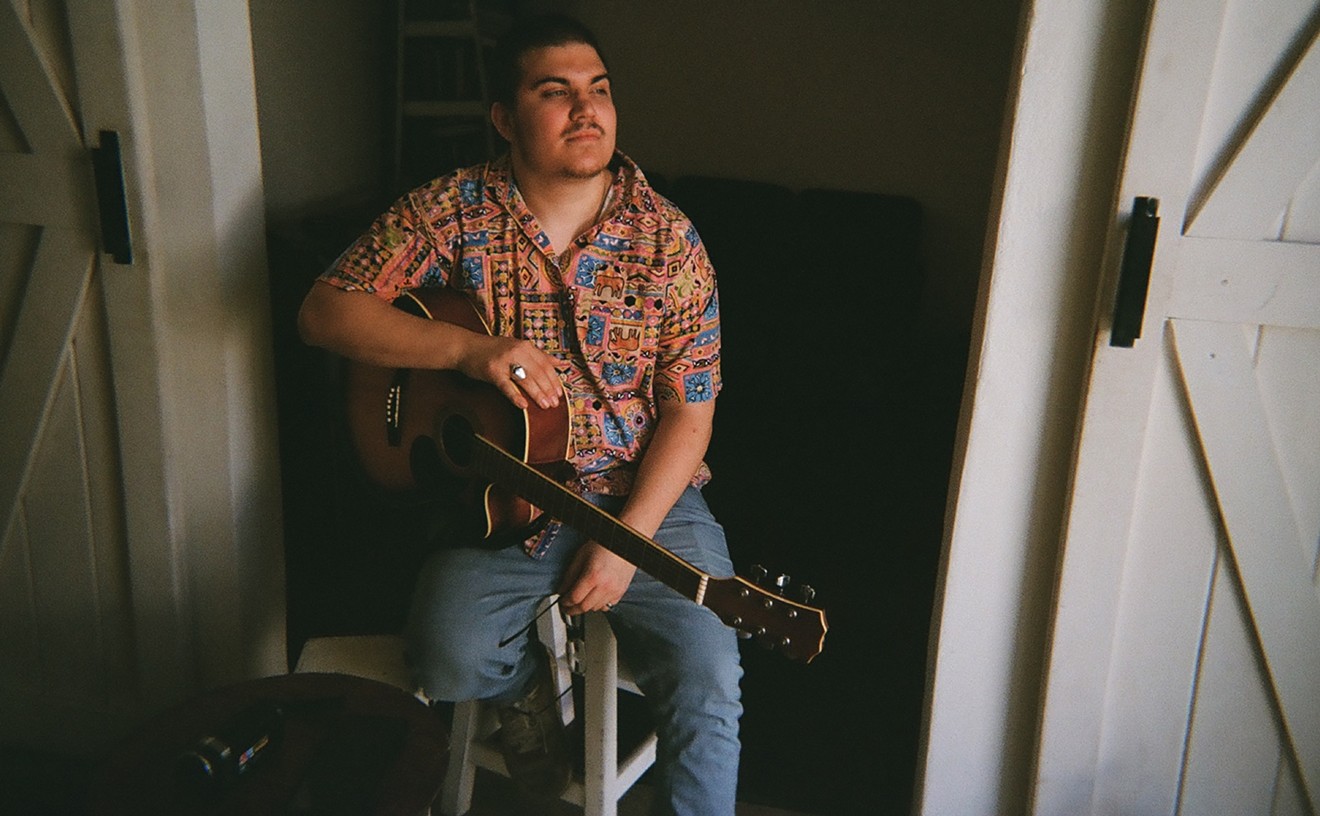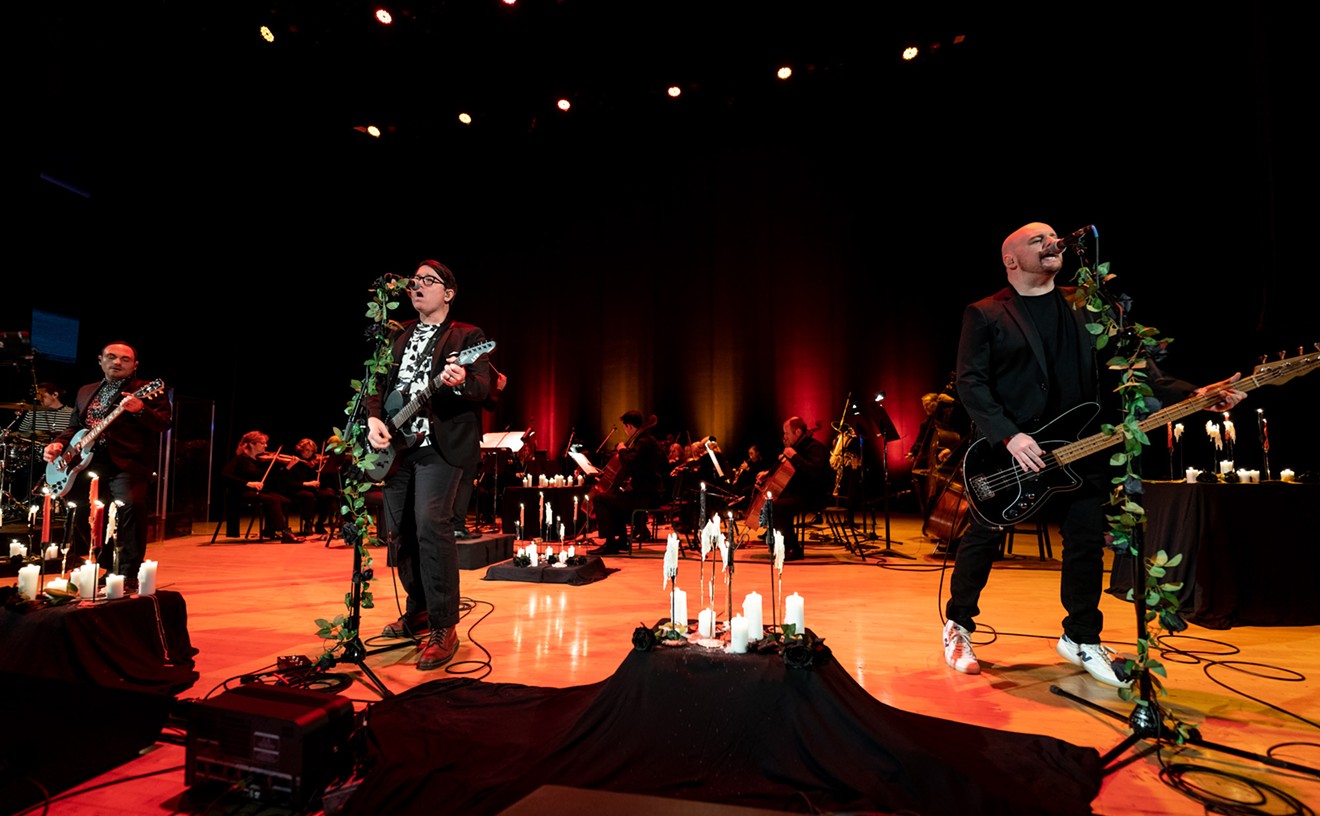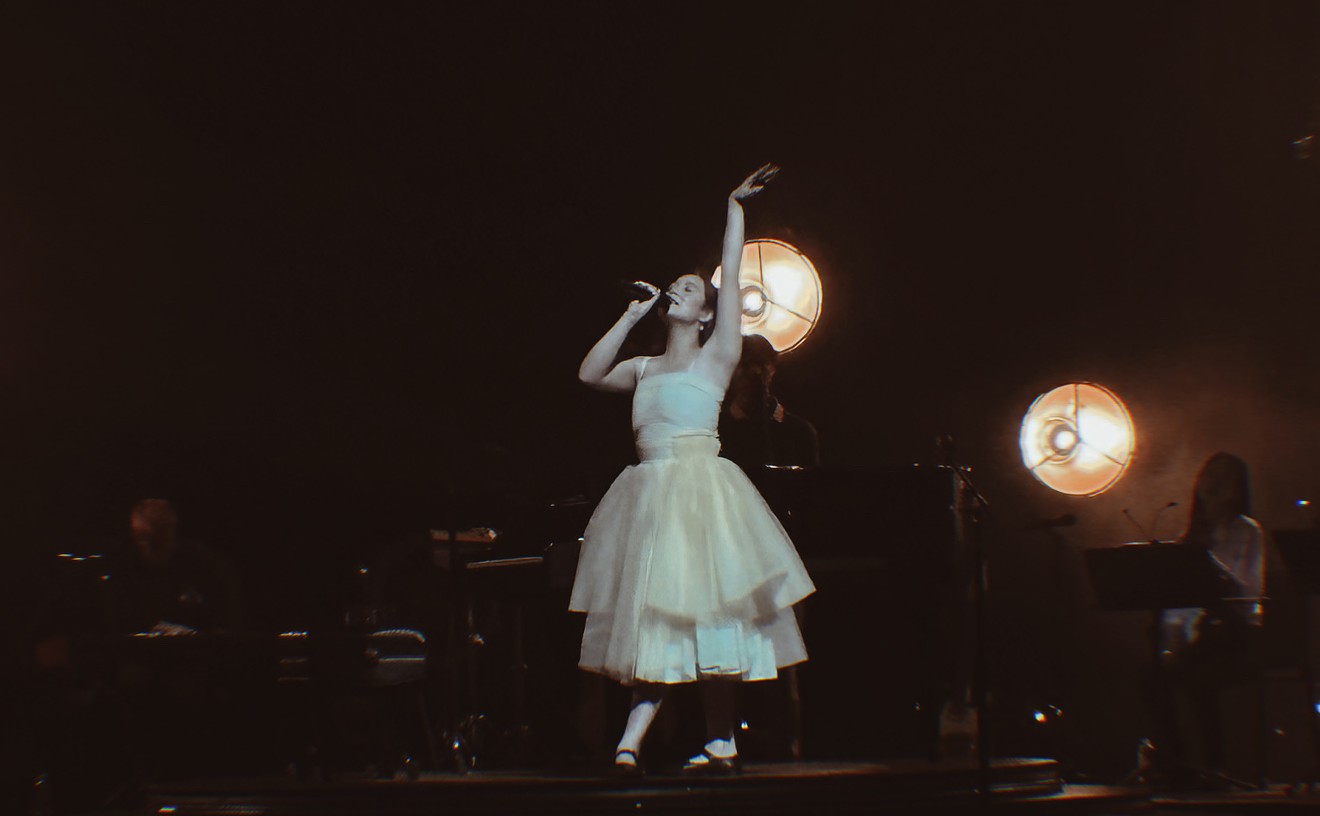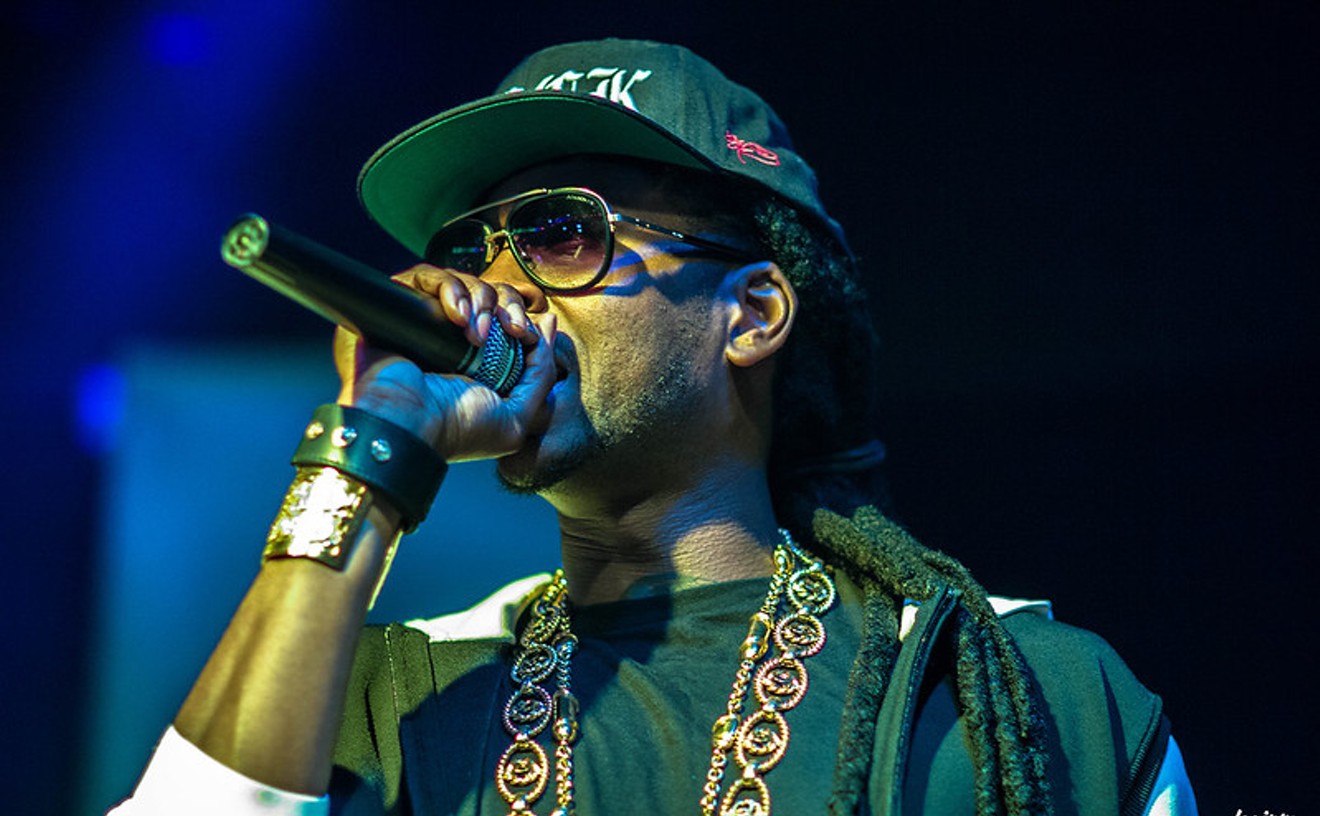In the middle of a tangentially related thought, for instance, she stops herself short: "What time is it there?" she asks from Canal Street Communications, her New York-based office, two days after the U.S. election. "Do you know who's president?"
It's 7 a.m., and nobody knows anything yet. And the way it looks on that fateful day, we might not know for a long time. Anderson sighs. "You know," she begins, "I never realized how much I cared about this election until I didn't know."
Mutual frustration over the election brings us slowly back around to American iconography and mythology, the subject we'd begun with. The signs and symbols of U.S. nationalism and patriotism have informed Anderson's work from her very beginnings as a performance artist in the early '70s, in New York's nascent "Downtown" scene. "I'm interested in those things because, in a way, it's a project that's so widespread. People everywhere work on the American mythos, whether they realize it or not. Not that I'm too concerned about mass culture, or about things spilling over into mass culture, but big cultural things interest me. They affect me; they affect all of us. Our basic assumptions are impacted on that level. I've been working on understanding that throughout all of the work I've done. And when I found that I was actually worried [about the presidential race], I started thinking about my own motivations, political motivations. I started to examine my assumptions, the reasons why I feel the way I do about certain issues, and I thought, 'OK, um...well, I don't like frat boys.'"
She laughs. But, as in Anderson's performances, her humor serves as a springboard for a larger, crucial question: "It's that basic, that clichéd, the way we tend to respond to these questions about national leadership. And the more I realized that, I thought, 'Wow, you're one big mass culture all on your own.'
"I have this friend who studies dolphin language," she continues (in that so-familiar voice), "and one of the things they found out early on about dolphins is they talk constantly, all the time; they even talk in their sleep. All day, swimming around in circles and going, 'blah blah blah.' So my friend studied this for about three years, you know, 'What are they talking about, what are they saying?' And what he found out was, they were all talking about status: 'Who's the top dolphin? Who's No. 2 dolphin? Who's going to be top dolphin? Who's the last dolphin?' And my friend said to me, 'Think about it: 90 percent of all your interactions, when you really take stock of the way you're connecting with people, begin from an awareness of status.' Not the words you use, necessarily, but the way you speak to certain people in certain positions. And I thought, 'No, not me, I'm democratic and all.' But I tried it, and it was true. You talk to the cab driver a certain way, the ticket taker, the salesperson...most of your interactions, not what you say but the way you speak, have to do with status. So it's not just a human narcissism or egotism; we want to eat, we want to know who's in front, who's going to provide these things for us, food and whatever. That awareness, and that level of communication, is all about survival.
"And then I realized [my worry] about the election, and I thought, 'Well, no wonder I'm scared.'"
Few contemporary artists have tested the abilities of the human voice--its tempos, its cadences and registers, and its ability to preserve and mutate our common history--as fully as Laurie Anderson has. From her experiments with voice modulation and patterns of speech in songs like "Walk the Dog" and "Say Hello" to her music and spoken-word collections The Ugly One With the Jewels and Stories From the Nerve Bible (a companion to the likewise-titled book), Anderson's art has rigorously examined the ways we speak to one another, the ways we use language in our attempts to communicate--or, just as often, to obfuscate those thoughts we'd rather not hear spoken aloud. A new double-CD collection on Warner Bros./Rhino, Talk Normal: The Laurie Anderson Anthology, provides a remarkably coherent overview of her musical work, considering how resistant to excerpting Anderson's art might initially seem.
Anderson kept a hands-off approach to Talk Normal. "The record company actually picked the songs. They offered to let me have input, but...ooh, that would have meant I'd have to go back and listen to everything all over again, which would have put me in a state of utter despair. It was eerie to hear it in the final stages, for the sequencing; they picked things I wouldn't have picked...you know, I'd be listening and a song would come on, and I'd think, 'What's that doing there?' I find that I like the simpler stuff more, when I go back and listen to it now, the more minimal songs. There were a couple of tense moments; I can kind of hear the '80s sound, that heavy production period, go by all at once. Oof. [Rhino] did a really good job with the selection, I think. They're great people."
Anderson further reports that she wasn't frustrated by the "anthologizing" process, which presents individual tracks quite outside of the overall context of albums like Big Science, Mister Heartbreak, Bright Red, or (most notably) the five-album set United States Live, a document of the mammoth multimedia show Anderson assembled during the early 1980s. Likewise, though many of the pieces represented on Talk Normal were originally designed to accompany visual elements, she doesn't see those selections as incomplete in their recorded form.
"It didn't frustrate me at all, really, because I've always been interested in what you're left with when you take something away. Like when you remove what you think is the best element of a piece; often you come up with something better. Most of those songs on the anthology were written for visual accompaniment, but the shape of that accompaniment still remains when you take the original center out of it."
This awareness of the missing center, the hole that remains when a relied-upon element is removed, informs a great deal of Anderson's work, which, for all its serious grappling with complex ideological issues, is some of the most accessible performance art ever produced precisely because it's composed of the utterly familiar. For the same reason, it has the power to disturb on the level of our most basic experiences. The lost traveler at the beginning of United States asks plaintively, "Hello, excuse me. Can you tell me where I am?" only to be met with an ominous voice: "You can read the signs. You've been on this road before." The caller who receives fractured and disembodied answering machine messages on "O Superman (For Massenet)"--Anderson's 1981 single, which began her career as a recording artist--cautiously repeats "Who is this really? Is anybody there?" but receives no satisfactory answer. Even her uproarious reworking of the tale of "The Monkey's Paw" on 1989's Strange Angels, her most pop-oriented album, warns that "Nature's got rules/And nature's got laws"--a small but essential caveat in the midst of a seemingly lighthearted tune.
But Anderson's body of work is also playful and good-natured, often laugh-aloud funny, and completely unpretentious (a too rare quality, to speak charitably, among artists as serious as Anderson assuredly is): "I see myself," she reports telling a group of Los Angeles music executives in the song "Yankee See," "as part of a long tradition of American humor...Bugs Bunny...Daffy Duck...Yosemite Sam." Anderson's humor is fully in evidence on Talk Normal, with its inclusion of "Walk the Dog," the joyous "Babydoll," and the classic "From the Air," which narrates an emergency crash landing as a Simon Says game ("Captain says put your hands on your knees, put your hands on your head/Heh heh heh"). But as with Andy Kaufman, for whose public guerrilla-comedy experiments she sometimes played straight man (movingly recounted in the song "The Rotowhirl," anthologized here), Anderson's brand of unsettling comedy requires an audience's emotional investment in order to complete its function; to listen to Anderson's tales passively is to rob yourself of their most beautiful and awe-inspiring elements. In fact, her most essential artistic strength might, like Kaufman's, be her refusal to create performances that separate artist from audience or to engage in any kind of distancing in order to provide a safe zone in either position. Coming to Anderson's art requires us to be as open as she is. For that reason, the shock we sometimes feel in reaction to her work is almost invariably the shock of finding ourselves in formerly banal settings rendered unfamiliar by way of an added or amplified element.
"It takes years to catch up with a person like Andy," Anderson says in terms that would also serve to describe her own body of work. "I saw him for the first time in this Latin club in Queens, and he was doing his act where he'd play the bongos while he was sobbing, openly sobbing. It was so fantastic. It woke everyone up, and you sat and listened and eventually you thought, 'Wow, yeah, this is really sad.' And it terrified me. It excited me and it terrified me because there was absolutely no context for it. That's also what I loved, what I love, about the avant-garde, that there's no precedent or context. Eventually, the real spirit of what he was doing won't be absorbed because he was so terrifying. With the movie [Man on the Moon], they kept asking, 'Couldn't you be a consultant or something?' but I couldn't bring myself...it was difficult enough for me to imagine watching anyone pretend to be Andy, because Andy himself was so much about pretending. And Andy was a friend, which made it hard.
"We like to be entertained; we don't normally like to be scared, but...people remember him: 'I don't know who that guy was, but he scared the hell out of me.' You want to be moved, you want your heart to fly out, but it doesn't normally, because you're listening to something that's been packaged and made to manipulate you. Not that Andy wasn't a master manipulator. But that's the great thing about being alive. You only really get to see a thing like [Kaufman's performance] once. Because once it's recorded and played back, you're already at one remove from it."
Yet Anderson's art is very much affected by the process of recording and playing back, a lifelong use of technology for her own artistic ends. At the same time, her work is largely given over to the use of storytelling as an artistic vehicle, which poses a particularly acute challenge, given how much contemporary technology has to do with nonlinear narrative, hypertextuality, and the immediacy of digital editing. Currently involved in the final mixing of her newest as-yet-untitled album, Anderson has been thinking about these issues much more urgently these days.
"Yes," she responds emphatically to a question about whether current technological advances make it more challenging to sustain the extended narratives that mark her work. "There's really quite a steep techno-curve. It's challenging for me because I work in so many kinds of media, and what that means is, I have to read a lot of manuals. I'm very dependent on the technology to do the things I do, and even if I know, say, 75 percent of the technology I'm using, the remaining 25 percent can really hang you up. Listening to the new album, for instance, the digital recording we did...with digital, the edits are very quick and easy, but it also means you get ghosts from the previous recording popping up unexpectedly. We were just listening to one song from the new album, and this really weird singing started popping up in the middle of the song. We can't figure out where it's coming from. So the process tends to call attention to itself.
"As someone who loves intricacy, I love the instantaneous nature of that, but it can fracture a narrative, a story, a word, a musical phrase. And there is nobody in the world who can tell me that the digital process doesn't lose something in the spaces, the silences between the notes."
On the song "The Night Flight From Houston," Anderson recalls sitting next to an elderly woman who is taking her first airplane ride. The woman looks at the lights of the cities below, describing them excitedly; and midway through her commentary it becomes apparent she thinks that they're stars, that the airplane is carrying them all through outer space. Careful not to brashly correct this innocent and essentially harmless mistake, Anderson offers only a hesitant "I think they're cities," but doesn't press the point. Anderson is engaged, now as ever, in mining the intersections between our most cherished beliefs and the flood of information that threatens to shake those beliefs at any given moment.
To perform that work, she's learned to pay attention to the silences between the notes; having spent more than two decades encouraging us to hear those sounds along with her, she's more than earned the career-spanning retrospective that Talk Normal strives to provide. The clarity of her vision is so apparent throughout these two discs that even the echo of that lost traveler--"Can you tell me where I am?"--is finally answered. Anderson's long work is saying, This is where we are today, and this is what the road looks like. That may be all the answer we get.
Or all that we need--being engaged, like Anderson herself, in the ceaseless and necessary act of moving forward.










